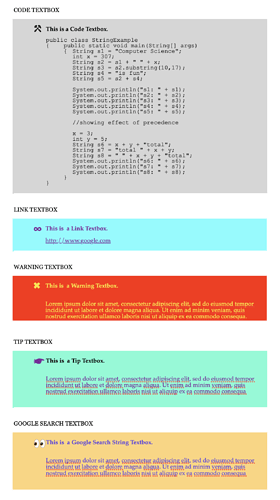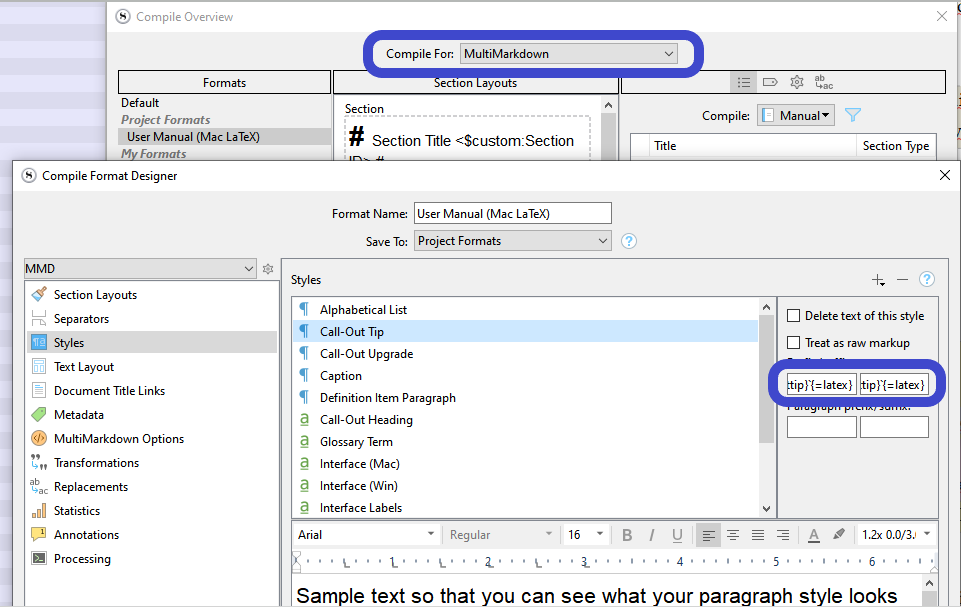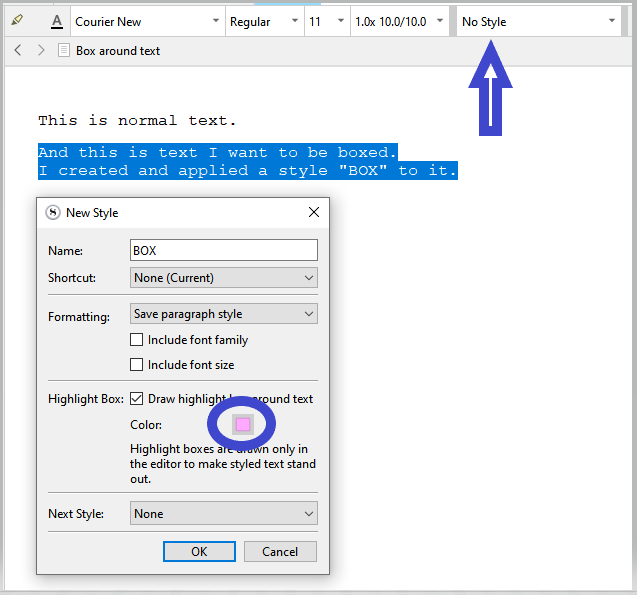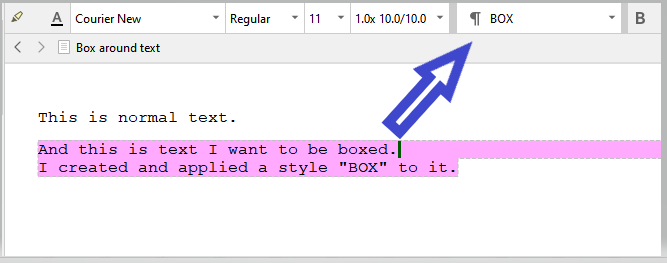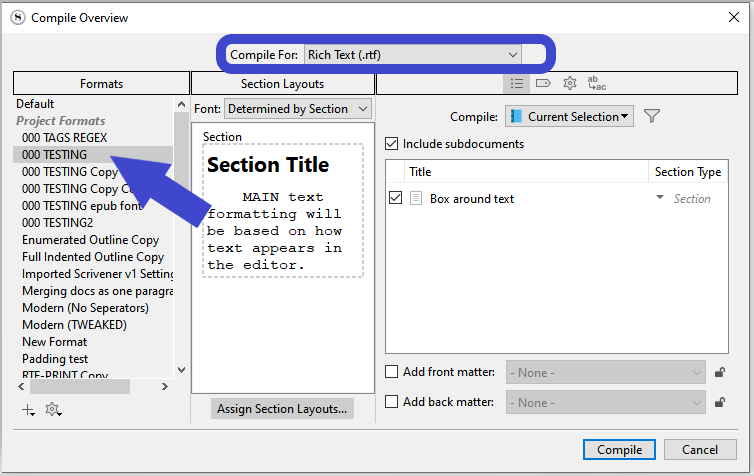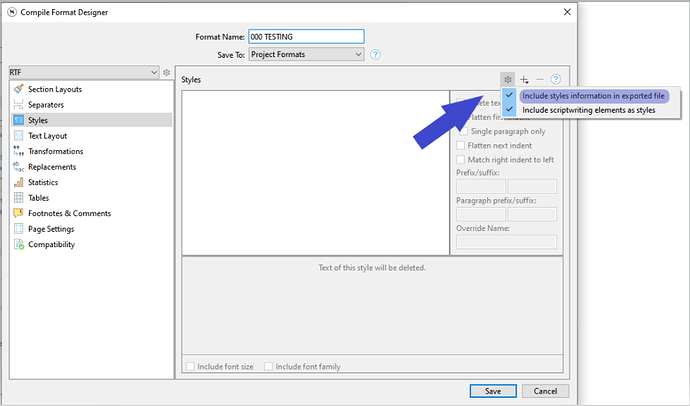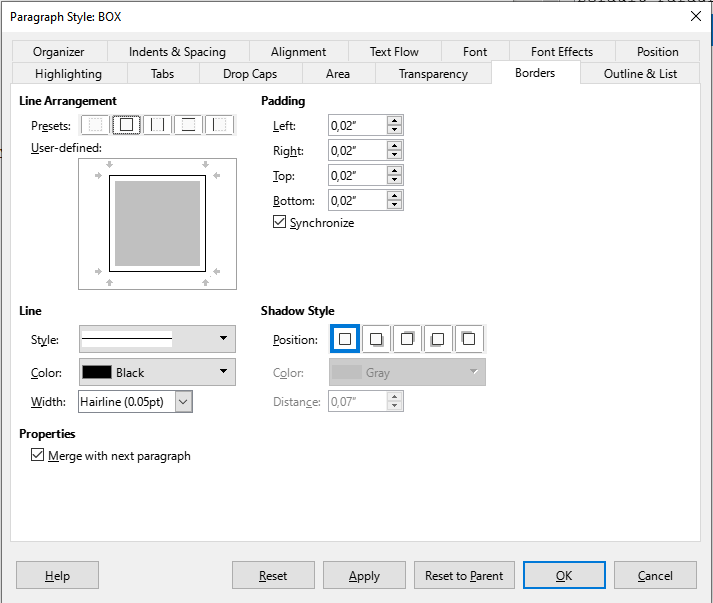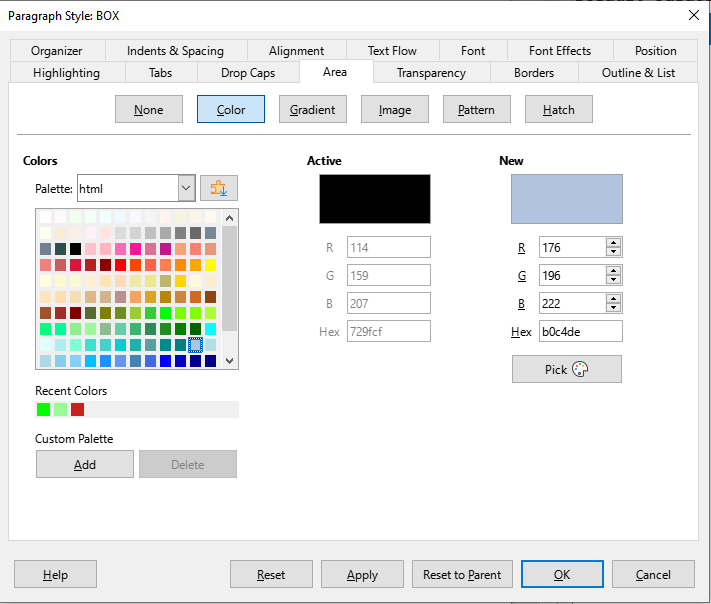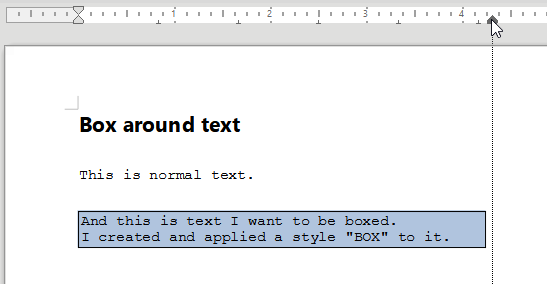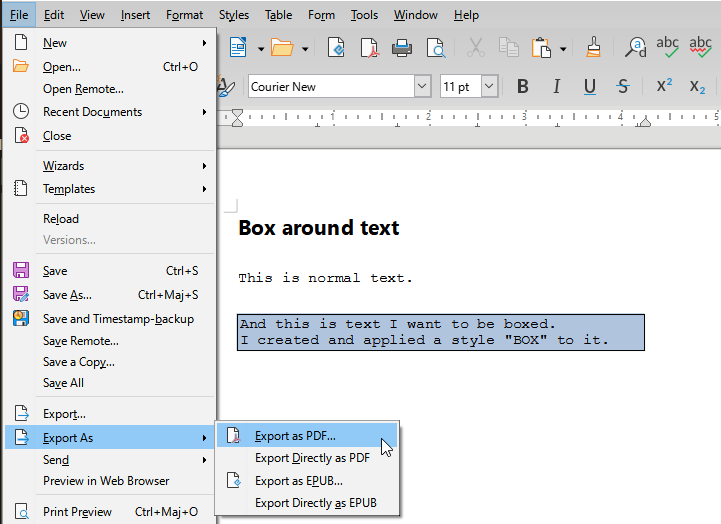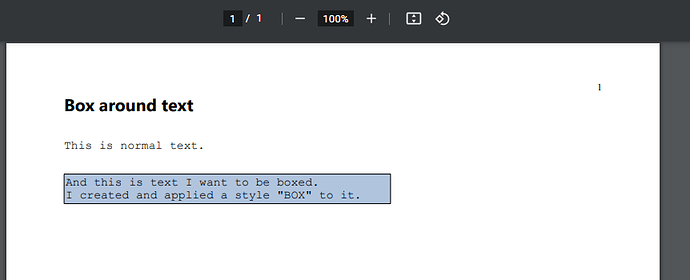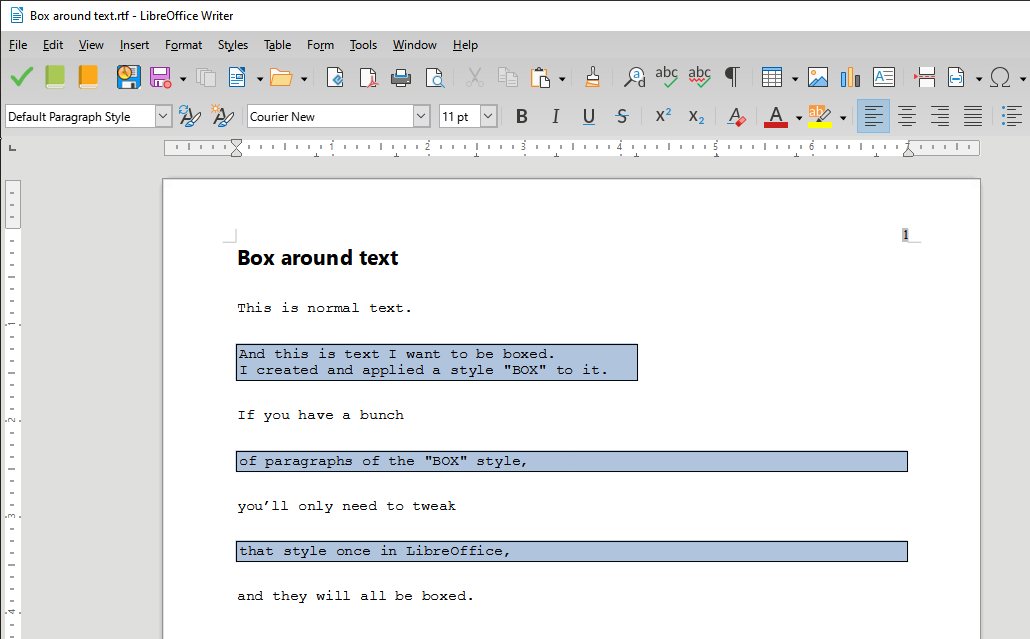Formatting yes, but in relation to the above discussion, of putting stuff (specifically LaTeX syntax) around text in order to create custom formatting that travels beyond Scrivener, not all of those types of formatting can do that. So the options are a bit more limited there—but it’s still quite a lot!
Meantime I built a few “text boxes” using Scrivener tables.
Each text box in the following screenshot was constructed using single row/4 column tables. Columns 1 and 4 simply indent the textbox. Column 2 contains the obviously optional symbol and Column 3 contains the actual text.
Regarding the text itself I modified the Block Quote style slightly for spacing.
Looking forward to finding out how this will work in practice.
I’d post for the forum the page w/ a style sheet but haven’t figured out if that’s possible.
Hi there,
I’m trying to use styles to create a bordered section in the manuscript with a background in a different color. I saw that in the Scrivener manual something similar is achieved with the styles “call out tip”.
So I imported the styles from the Scrivener manual, and when I apply the “call out tip” style I get the effect I’m after, but I have a few questions:
- How do I change the background color if I don’t want it to be yellow but grey for example?
- This works fine in the editor when looking at scrivenings, but when I compile to PDF the paragraph formating is kept but not the different background color. What do I have to change so that the background/border applied by the style still shows in the compiled document? [EDIT: thinking about this, I guess it would only work if I take that section out of the section it’s in and make that section “as is”. I’ll try this tomorrow. I guess the question becomes can you define a style with such attributes in the section layout].
- How do I control the indentation in the style? It seems to flatten all indents, but I’d like to keep them. I’m not sure how to change that aspect in the style.
Thanks for your help!
Simply modify some text of that style in the editor, then (with a chunk of it selected) :

Pick your style from the list.
You’ll be able to change the background color in the consequent popup. (Style’s settings panel.)
. . . . .
To modify the indent:
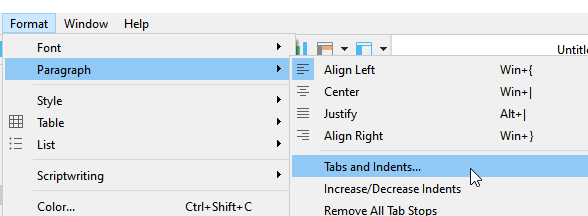
Can’t be done.
That border + background is only a cue, visible in the editor.
To achieve this, you’d have to compile to a third party text editor that supports the styles.
(Meaning you’d assign the styles in Scrivener, in prevision of what you want to later achieve.)
I am a Windows user, so I can’t recommend any specific app to you.
But under Windows (just to give you an example), I’d compile to RTF, then set my style’s background and border in LibreOffice, and from there export to PDF.
Otherwise, as to how it was done in the manual, that has got to be a LaTex feature or something of the kind. I personally wouldn’t know how.
But what you see in the resulting PDF is not the border and background you see in the editor.
[EDIT] I downloaded the user manual’s project and had a look, it is indeed Markdown (MultiMarkdown) and LaTex.
Unless you are an expert (or plan on becoming one), safe to say that you’ll find the third party app solution much easier.
Thank you very much for the detailed answer, much appreciated.
Re the compiling issue, I guess I’ll have to put this as a feature request. It would be really useful to be able to compile such “Call out tips” into a print manuscript / PDF.
I’m also a windows user, I still use the Mac because there are too many limitations and bugs in the windows version to use it when compiling to PDF/RTF. Just in case these issues are fixed at some point, which Window app would you recommend?
Thanks again for your help!
I’ve merged your post with an existing discussion on this matter. If you refer above, I describe how I make these in the user manual. Since you mentioned in another thread that you use Markdown, the implementation may be much more directly applicable if you are using LaTeX to get to PDF.
I don’t know though, at other times you speak of compiling to RTF and such, so it’s not clear. If you are not using Markdown then the right answer to this is to not bother trying to do this in Scrivener. Just create your styled text, mark it with a highlight or whatever you want, and let the desktop publishing system or word processor you use handle this with its ability to draw proper boxes.
@Vincent_Vincent - just wanted to say how amazed I am at the thoroughness of your responses on these forums. They are truly on a different level. ![]()
You just made my day.
![]()
Thanks mate.
I second this, thank you, this is very useful and I really appreciate the time it took you to provide all this info. I’ll give it a try if/when Scrivener Windows catches up with the Mac version.
As the software is in constant development, and things are developed for Mac, then adapted for Windows, that might very well never happen. ![]()
This aside, all you need is a Mac app you can use as I used LibreOffice.
One that uses styles and that is compatible.
It’ll work, just the same.
— Better (seems like LO runs on a Mac, too) :
The PC version is close though, there are only a few bugs and a few features missing (like the ability to start a section on a recto/verso page). I hope they’ll get there as I’d really like to be able to do everything from the PC (I replaced my Macbook Pro with a Dell XPS when they decided to drop Intel and Bootcamp).
I use a Mac VM to compile, because of these limitations/bugs on the PC version, so I could even compile to RTF on the Mac and use Word on the PC host to do this.
I just resist making my workflow more complex because it’s only me and it’s such a time-saver to be able to output to PDF or EPUB directly from Scrivener. I don’t think I’ll go back to having to use other software in the workflow, it multiplies the risk of errors and slows everything down.
Thanks again for all your help, the info is there is I change my mind. ![]()
Why didn’t you just use Parallels and ARM 64 Win on a new MacBook Pro? Works a treat, better than Bootcamp ever was (and I’m recently ex-Apple).
AND, you don’t breach anyone’s license terms/pirate (Running a macOS VM on a Win Device if I read correctly)
Because I do video editing and games and that Parallels doesn’t work well performance wise for these types of app (I did use parallels when I had a Mac, but only for office type apps).
Also there are lots of drivers that are not available for ARM. For example meter drivers for calibration software.
Plus until last week there was no legal way to use Windows for ARM on parallels as it was not officially allowed and was unsupported by microsoft, so you were breaching a license anyway. ![]()
I made the decision last year and didn’t feel comfortable to commit to Apple Silicon until they had made a decision re bootcamp or Microsoft announced support for Windows for ARM in Parallels. The latter is now confirmed, but they have ditched bootcamp, so Apple is dead for me.
Very happy with my Dell XPS 17, and I’m hoping to dump my Mac VM as soon as Scrivener for PC has caught up with the Mac version compiler-wise. I only use the Mac VM to run Scrivener for compiling.
Anyway, back to topic… ![]()
I do video editing but use Mac software, however, I just fired up Premier Pro on Win/Paralllels and it runs a treat on 4k footage. I have an M2 Max MBP.
I wasn’t breaching a license under the insider program, I asked MS on that and was told that, while their contractual agreements prevented the retail release on anything other than Qualcomm ARM, under the Insider I could. Apple is very specific about theirs.
I genuinely hope you have a better run with your XPS than I had with my last two Dell notebooks (1 XPS). Apart from monitors, Dell is dead to me.
